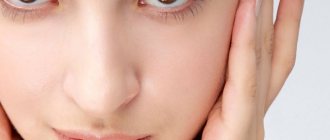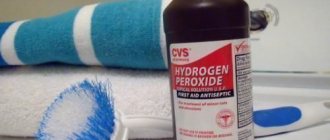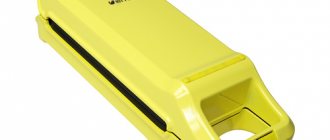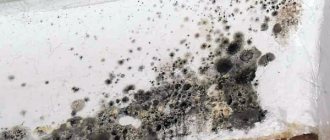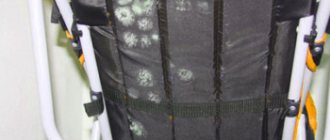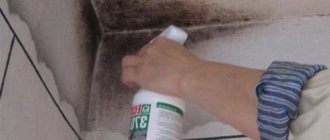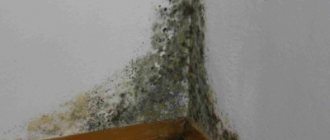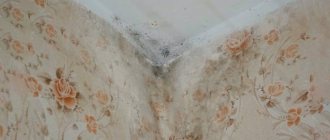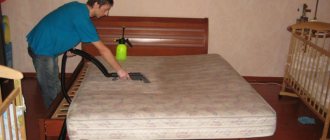Good day!
My name is Khalisat Suleymanova - I am a herbalist. At the age of 28, I cured myself of uterine cancer with herbs (read more about my experience of recovery and why I became a herbalist here: My story). Before being treated using traditional methods described on the Internet, please consult with a specialist and your doctor! This will save your time and money, since the diseases are different, the herbs and treatment methods are different, and there are also concomitant diseases, contraindications, complications, and so on. There is nothing to add yet, but if you need help in selecting herbs and treatment methods, you can find me at my contacts: Khalisat SuleymanovaInstagram page: instagram.com/fitoterapevt1
Telephone: 8
Email: [email protected]
I consult for free.
Mold is a type of fungus that loves damp places in the home, especially areas of organic materials - food, leather, clothing, paper, wood, etc. This dark-colored fungus is not only unsightly, but can also pose a health hazard to anyone living in the area. The fungus can easily cause respiratory illnesses. Therefore, it is urgent to get rid of it. And removing mold with hydrogen peroxide is one of the best folk methods. Make your home clean and safe.
Surface treatment
Hydrogen peroxide can be effectively used to disinfect kitchen counters and cutting boards. To treat surfaces, you just need to soak a cotton pad in peroxide and wipe the table or board with it. Leave for 10 minutes and then rinse with cold water.
The developer said that Sputnik V will protect against current variants of coronavirus
I tie the laces using a knitting needle: the knot turns out neat, the tails don’t stick out
“Changed beyond recognition”: fans worry about Tatyana Dogileva
Precautionary measures.
When carrying out professional self-treatment of an apartment for mold using hydrogen peroxide, you should remember some rules that can help save your health from the effects of a chemically active drug. To do this, it is necessary to use protective equipment, for example, goggles, gloves, a protective gown and a headscarf. In addition, you should try to avoid getting hydrogen peroxide on all mucous surfaces of your body: you should not allow peroxide to get into the digestive tract, or onto the surface of the mucous membrane of the eye, or into the nose. Try to apply peroxide very carefully.
Medical use
To treat foot fungus, you need to mix hydrogen peroxide with water in a 1:1 ratio. Apply the prepared mixture to the affected areas every evening.
Hydrogen peroxide is an excellent remedy for those who suffer from neck pain due to the fact that they often have to sit in an uncomfortable position. If your neck is stiff and you feel excessive tension and discomfort in the muscles, then you need to take a handkerchief, soak it in peroxide and apply it to your neck. Place a warm towel on top. Leave the compress for 10-20 minutes. This product perfectly warms up the muscles, eliminates pain and strain.
Peroxide helps to quickly and effectively get rid of a runny nose. To do this you need to mix 1 tbsp. l. peroxide with 1 tbsp. still mineral water. Use the prepared product as a nasal spray.
To get rid of ulcers and wounds in the mouth, you need to take 10 ml of hydrogen peroxide, put it in your mouth and hold it for 5 minutes, but do not swallow. In addition, this product helps whiten teeth and reduce the likelihood of tooth decay. This is why peroxide can be used as an alternative to store-bought mouthwashes.
Sometimes peroxide can be used to replace a solution intended for disinfecting contact lenses. It helps break down proteins that accumulate on lenses.
To reduce discomfort and sore throat, you need to mix ½ tbsp. warm water with ¼ tbsp. hydrogen peroxide and gargle well. This remedy is a very good prevention of colds, as peroxide helps destroy pathogens.
To clean the ears, mix 1-2 drops of hydrogen peroxide with a small amount of warm water. Dip a cotton swab into the prepared solution and clean your ears. This product will help remove the wax that has formed.
What kind of mold does hydrogen peroxide remove?
When used correctly, H2O2 copes with extensive mold lesions. This solution kills any fungus, brightens the affected areas and prevents its reappearance.
But, nevertheless, in order to more quickly achieve the desired result or if fungal colonies form again, still use more aggressive anti-mold agents.
Which peroxide will help against mold? Unlike store-bought chemicals, H2O2 has a number of significant advantages:
- practically odorless;
- there are no harmful fumes during foaming;
- non-toxic.
Buy two types of solution at the pharmacy - 3% and 6%. The price of this product is not high, unlike chemical anti-mold solutions from famous commercial manufacturers.
Don't forget: peroxide has the ability to lighten!
See also:
- Mold on the windows. What to do?
- Mold in the shower stall: how to get rid of it once and for all;
- Mold on jam. Dubious "delicacy"
- How to get rid of mold on the ceiling in the bathroom: effective removal;
- Mold: what it is, what it is and why it appears.
Application of antifungal primer
It is recommended to purchase an antifungal primer at any hardware store. Its application to the walls from the inside will reliably protect against the appearance of fungal mold. It is advisable to treat the walls with an antifungal primer immediately after building the steam room.
The primer must be diluted with cold water until a medium-thick consistency is obtained. Apply to the wall surface using a brush. Be sure to treat all corners and hard-to-reach places with an antifungal primer.
Why is mold dangerous? *
There is a lot of material in the literature on the dangers of mold for animal and human health.
Some types of mold and fungus cause diseases - aspergillosis, onychomycosis and others.
For children, whose immune systems are much weaker than adults, mold is especially dangerous.
Here are the symptoms of the disease “Aspergillosis”
caused by fungi of the genus Aspergillus:
- It can be asymptomatic
and detected only by X-ray examination; repeated coughing with hemoptysis is possible, sometimes even leading to fatal bleeding. - Invasive pulmonary aspergillosis
is usually acute and progresses rapidly, causing shortness of breath, cough, fever, and chest pain. It is possible for the infectious process to spread both to neighboring structures and hematogenously to other organs. - Aspergillosis with damage to internal organs
has a severe course, occurring with fever, chills, and possible development of shock, delirium, and thrombosis. There is a risk of developing kidney and liver failure and breathing problems. - Aspergillosis of the external auditory canal
(otomycosis) causes itching and sometimes pain. Fluid leaking from the ear at night can leave wet spots on the pillow. Aspergilloma of the paranasal sinuses causes a feeling of congestion and dull pain; in the invasive form, fever, ulceration and necrosis of the mucous membrane develop with nosebleeds.
Harm from mold
Black mold poses a great danger to everyone who lives in an apartment. It releases a large number of spores into the air, which easily enter the lungs and can cause diseases of varying severity. Living for a long time with a fungus can lead to pneumonia or even bronchial asthma, as well as a number of other serious problems with the respiratory system: frequent bronchitis, tracheitis and rhinitis begin, and severe shortness of breath appears. It is also possible to develop respiratory and skin allergies of varying severity. In addition, the growth of mold on the walls of a residential building can lead to severe headaches, frequent nausea and a general deterioration in a person’s condition. Psoriasis and candidiasis, which cannot be cured for a long time, can also be caused by mold formations. They have the greatest negative impact on children and people with weak immune systems.
In some cases, mold formations indoors can lead to the development of cancer.
In addition to causing harm to human health, the fungus can also ruin the condition of the apartment. This parasite can very quickly render wooden floors, primers, floors, wallpaper and furniture unusable.
In addition, it penetrates well into finishing materials and destroys their structure.
If a special antibacterial primer was not used when renovating an apartment, the fungus can begin to corrode not only the whitewash and plaster, but even the concrete base or brick.
What consequences can there be due to mold?
Mold can be quite harmful to both repairs and health. This fungus can cause the following diseases:
- asthma;
- various allergies;
- gastrointestinal disorders;
- infectious and skin diseases;
- bronchitis and others.
Simple measures to prevent mold from reoccurring.
Once mold has been eradicated, strict rules must be followed to prevent it from reoccurring.
Main precautions:
- Monitor the level of air humidity and temperature in the room.
- Install good ventilation in the apartment, house and ventilate regularly (morning and evening).
- When carrying out repair work, it is worth using a primer with antiseptic properties.
- Do not spray indoor plants too often or generously.
- Do wet cleaning with an antifungal agent a couple of times a month.
- In the kitchen, when preparing food, be sure to turn on the kitchen hood.
If plastic windows are installed, then make sure that water does not collect on the glass (if the windows sweat, look for the cause and eliminate it, wipe the windows dry).
Traditional methods against mold
If the extent of damage to the walls is insignificant, then further spread of the fungus will be prevented using available means.
The video presents a test experiment on the effectiveness of various folk methods for removing mold from walls:
Method 1: Bleach. The composition of “whiteness” and similar preparations includes sodium hypochlorite. The component has a detrimental effect on many types of fungi and mold spores. Disadvantages of the method:
- chlorine corrodes the surface and can ruin the finish of the walls;
- the active substance works superficially - the fungus remains inside the material;
It should be remembered that working with bleach is unsafe for human health.
Method 2: Bleach paired with baking soda. In addition to these main components, you will also need liquid soap and a few drops of an essential oil that is pleasant to you personally. In general, preparation and use are not difficult to cope with:
Those who want to directly clean the bathtub white and put the plumbing in order will find a lot of very useful information on our website.
Method 3. Vinegar. An acidic environment is harmful to many bacteria. Table vinegar is non-toxic, but produces a strong odor. This drawback can be easily eliminated by ensuring sufficient ventilation.
Vinegar is sprayed onto the damaged surface or applied gently with a sponge. After one hour, the wall is washed and the room is ventilated
Method 4. Hydrogen peroxide. The solution has antiseptic and antifungal properties. Treatment with a 3% composition is effective, but is fraught with the appearance of stains on the wall - peroxide bleaches the coating.
To apply the product, it is advisable to stock up on a spray bottle:
Method 5: Baking soda. The simplest and safest method is to simply spray the wall with a soda solution (1 teaspoon of sodium carbonate per liter of water). After 1 hour, wipe the surface with a dry cloth. It is not necessary to remove the remaining solution - the soda will prevent the re-formation of the fungus.
Method 6. Borax (aka sodium tetraborate). The use of natural cleaning products is a priority in terms of maintaining a clean environment.
Borax can be purchased without problems and prescriptions at any pharmacy at a very affordable price.
Method 7. Ammonia. In this case, no additional funds or drugs will be required, although the cost of ammonia cannot be called the most budgetary.
It is strictly forbidden to mix ammonia with bleach, so as not to be poisoned by the extremely toxic gas formed when these chemicals combine. It is also unacceptable to add to household cleaning products based on chlorine or ammonia, for example, to window cleaning liquids.
.
In order not to have to re-treat apartments against clearing using hydrogen peroxide, it is necessary to comply with all basic norms and rules of treatment, as well as maintain cleanliness in the apartment.
To do this, ventilate the rooms often, maintain proper ventilation, and if necessary, carry out repairs in the apartment and ensure the room has normal air circulation. In addition, it is necessary to wipe the dust in the apartment every day and ensure that all surfaces of the furniture in the room are completely clean: use dry rags using microfiber, and also change the entrance mats before entering the apartment several times a year.
Tea tree oil
Tea tree has antiseptic properties. To combat mold, you need to prepare a solution: mix one teaspoon of oil in a glass of water. The product can be applied using a sponge or sprayed from a spray bottle. For a lasting effect, it is not recommended to wash off the tea tree. The oil has a peculiar smell that dissipates fairly quickly.
tea tree oil
We use bleach
Household chemicals with a whitening effect are not natural, however, they are quite affordable. It should be borne in mind that these products are quite aggressive, so they are diluted with water. The dilution method and proportions are indicated in the instructions on the bottle or at the rate of 1/10.
Bleach is great for glass, tiles, bathtubs, and other non-porous materials, but is powerless for drywall and wood.
It is very important to think about protecting the skin and mucous membranes. It is better to carry out the cleaning process in a well-ventilated area
The solution is applied to the walls using a stiff brush. The procedure can be repeated again, and then thoroughly clean the surface.
How to get rid of mold in the bathroom?
The bathroom, due to its high humidity, is a favorable environment for the formation of mold and the rapid growth of harmful fungi.
This problem cannot be tolerated; mold must be removed as soon as it is discovered, since its appearance is fraught with the development of various diseases in both adults and children.
The consequences of the spread of mold can be dermatitis, allergies, bronchial asthma, disruption of the functioning of the gastrointestinal tract and central nervous system, as well as many other diseases.
At the same time, children, due to their fragile immunity, are at a much greater risk of infection.
In addition to the fact that mold has a detrimental effect on human health and is accompanied by a musty, heavy odor, it also destroys building materials and finishing.
Therefore, if you are sure that mold will not appear in your bathroom, it is still recommended to carry out certain preventive actions at least once after a few months.
The issue of prevention and complete disposal of mold must be approached with great responsibility, first by identifying its favorite places, namely walls, ceilings, joints of tiles and panels, corners and pipes.
In bathrooms, black mold, identified as Aspergillus niger, often occurs in the form of black spots spreading along the walls.
It is worth noting that fungal spores are always in the air in a dormant phase, but become more active when favorable conditions arise for them.
But they spread quite quickly, growing in new areas.
What conditions influence the formation and rapid spread of mold:
- High humidity from 80%
- Temperature over +20C
- Unventilated area
- Poor tightness of the ceiling or wall joints, presence of cracks
- Freezing of walls (the case is more applicable to street buildings).
How can you get rid of black mold?
Removing mold is a labor-intensive process. To protect the mucous membranes and respiratory tract from fungus and when using chemicals, you should wear a protective mask and rubber gloves.
First, you need to clean the affected areas from mold, using any detergent in combination with a special scraper or wire brush, and it is important to remove the fungus completely from the surfaces, trying to completely eliminate it from the greatest possible depth. This is because the mycelium is capable of penetrating deep enough into the material, and if it is not possible to completely clean it out, the entire processing process will be ineffective, which means mold will appear in the very near future in the same place.
IMPORTANT: The sponges and cloth that you will use when cleaning mold from the wall must then be thrown away or burned so as not to spread the fungus to another part of the apartment.
In cases where scrapers are used, they should also be disposed of or disinfected in a special solution. After cleaning the surfaces from fungi, it is necessary to thoroughly clean the bathroom with special high-performance disinfectants, for example April Anti-Mold, which has a high antifungal protective effect. Next, the room must be thoroughly ventilated.
How to treat a bathroom from mold and mildew?
Experienced housewives use ammonia, or hydrogen peroxide, baking soda, citric acid and various other means to remove mold. But they do not get rid of mold for a long time, since they are not able to remove it completely.
Therefore, the Alterchem-Pro recommends using a special professional anti-mold product APRIL for the prevention and destruction of microorganisms. This product perfectly sanitizes the surfaces of walls, ceilings, interpanel seams and brickwork. Has a long-term protective effect.
How to use APRIL anti-mold?
After cleaning the walls from mold using a detergent or scraper, it is necessary to apply the product liberally with a brush, roller, spray or sponge 2-3 times after each previous layer has dried. It is also recommended to apply the product to neighboring, still “healthy” areas.
You can see more details about using the tool
.
Preventing mold in the bathroom:
If it so happens that mold does appear once, you can be sure that it will definitely appear again if preventive measures are not taken.
We list the conditions that will help avoid the appearance and spread of fungus in the future:
- Ventilation must be provided in the bathroom;
- Eliminate existing leaks in taps/pipes;
- Seams and joints in the finishing must be completely sealed;
- High humidity in the bathroom should be reduced (do not leave damp towels in the bathroom after washing, do not dry clothes here, etc.);
- Clean regularly with special products that have a high antifungal effect for prevention, paying special attention to corners, joints and walls;
- Protect walls from freezing.
Follow these instructions and use APRIL anti-mold and you can forget about mold on the walls in the bathroom, which means it will no longer harm your health and the health of your loved ones!
Special professional products to combat mold
If you cannot overcome mold with home remedies, then you should pay attention to special professional products. You can find various effective remedies on the Internet.
In order to understand how to treat walls against mold, you first need to analyze the scale of damage by this fungus, as well as what the walls are covered with. For different surfaces there are different special means for getting rid of mold; this point must be taken into account so as not to spoil the wood or wallpaper...
As a rule, the special product is based on a fungicide and biocide that effectively eliminates this type of fungus and prevents its occurrence in the future.
If you need to treat a wall with a special anti-fungal agent, you must first prepare it correctly:
- Plaster or completely remove material that is completely or mostly affected by mold.
- Cover any cracks that appear with putty.
- Dry well and then only treat with a special product.
Why does mold appear on walls?
There is a whole list of factors that contribute to the development of fungus. For example, malfunction of ventilation, problems with sewerage, mistakes made during the construction or renovation of an apartment. As a result, all the reasons for the appearance of fungus on the walls come down to dampness in the room.
Disruption of the microclimate due to high humidity leads not only to the appearance, but also to the rapid proliferation of fungus. For this parasite to appear, it is not necessary to have high humidity in the entire room; one damp wall or corner will be enough. The relative humidity in the room should not exceed 60%.
The most common causes of high indoor humidity:
- poor ventilation;
- faulty pipes and plumbing problems;
- constant drying of laundry indoors;
- frequent and long baths;
- a large number of indoor flowers that require constant watering, as well as the presence of aquariums;
- insufficient heating of the room;
- plastic windows that promote condensation in the room;
- insufficient ventilation, as a result of which the air in the apartment is not renewed;
- leakage of inter-wall seams and cracks in walls.
Important: a kitchen hood is a must. This is due not only to its ability to quickly eliminate unnecessary pan smoke and food odors, but also to the fact that high humidity is generated during the cooking process. Of course, if the house does not have a hood, then it is necessary to ventilate the room well during and after cooking. Otherwise, you will have to remove the fungus from the walls of the apartment.
